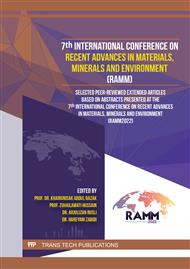p.149
p.155
p.167
p.175
p.183
p.189
p.197
p.209
p.219
Structural and Geochemistry of Air Piau Gold Mineralisation in Kelantan, North-East Peninsular Malaysia
Abstract:
The formation of the Air Piau Gold Deposit in North-East Peninsular Malaysia due to Permo–Triassic subduction and collision between Sibumasu and East Malaya blocks and resulted in several phases of deformation, contraction, and metamorphism. Kinematic and petrography study of quartz veins in Air Piau area observed whether following the foliation of metamorphic rock or crosscut the foliation. Early generation of veining system in Air Piau follow the host rock foliation (V1). Meanwhile the later formation of the hydrothermal vein has a cross-cutting relationship with foliation (V2). Some veins observed were sheared and brecciated (V3). Positive correlation between Au and As concentration that can be characterized these deposit formed at mesozonal zone. V3 vein type showed the brecciated texture of vein indicates the brittle structure deformation. The conceptual model of orogenic gold, this type of V3 vein can be classified as epizonal zone. Regionally, the Air Piau gold deposit shares geologically similarities (in term of tectonic setting, geological structures controlled, host rock, ore gechemistry) with many other sediment/metasediment- hosted, orogenic gold deposits in Peninsular Malaysia such as Tersang, Selinsing and Penjom. Furthermore, Air Piau gold deposit characteristics as discussed before supported the theory related with orogenic/mesothermal gold from various researchers However, a number of inferences on classified Air Piau gold deposit model as orogenic gold deposit remains speculative in the absence importance data like ore geochemistry data (Hg, Sb and Te element concentrations) and fluid inclusion data.
Info:
Periodical:
Pages:
209-217
Citation:
Online since:
March 2024
Price:
Сopyright:
© 2024 Trans Tech Publications Ltd. All Rights Reserved
Share:
Citation:



